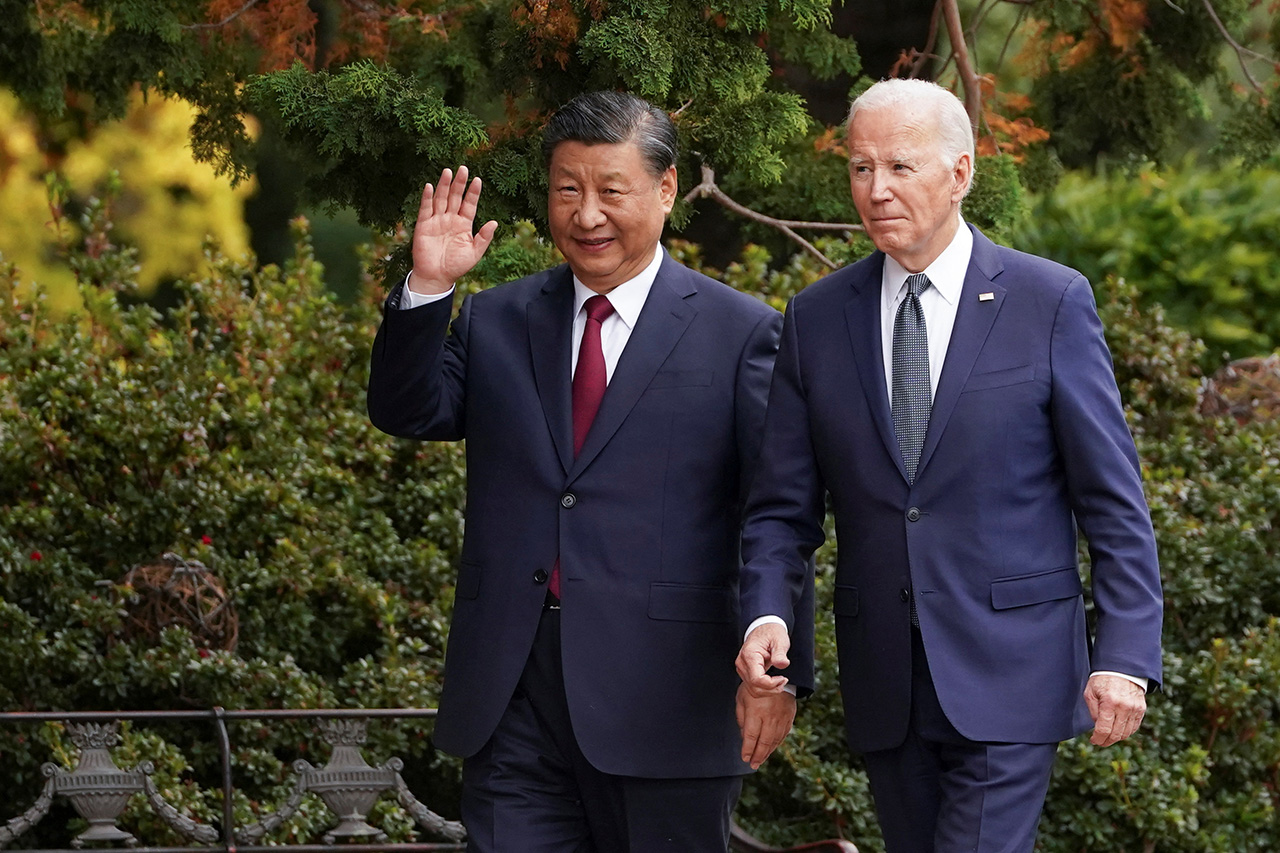Xi and Biden Meet in California: Progress but no Breakthrough
On 15 November, on the margins of the Asia-Pacific Economic Cooperation (APEC) summit in San Francisco, the U.S. and Chinese leaders met. It confirmed the willingness of the two countries to reduce tensions in their relationship. Among other things, the parties agreed to resume formal communication on military issues to reduce the risk of military incidents that could escalate uncontrollably and lead to open conflict. However, this does not mean an easing of tensions between the U.S. and China around, for example, the Taiwan issue and trade policy.
 KEVIN LAMARQUE / Reuters / Forum
KEVIN LAMARQUE / Reuters / Forum
The Circumstances of the Meeting and Main Objectives
The respective leaders of the U.S. and China, Joe Biden and Xi Jinping, met at Filoli House in Woodside, near San Francisco, which may have underlined the special nature of the event and the broader catalogue of common topics than just economic issues on which APEC focuses. It was their first face-to-face meeting since their conversation at the G20 summit in Bali last November, and Xi’s first visit to the U.S. since 2017. In preparation for the top-level talks, a series of senior Biden administration visits to China took place in recent months, as well as a trip to Washington by Chinese Foreign Minister Wang Yi. These were meant to reduce bilateral tensions caused by, among other things, the U.S. shooting down of a Chinese spy balloon in February this year or Chinese provocations in the South China Sea, including against U.S. ally the Philippines. Through the Xi-Biden meeting and the expected calming of bilateral relations at the political level, the Americans wanted, among other things, to gain more leverage in other areas, such as helping Ukraine, attacked by Russia. The outbreak of Israel’s conflict with Hamas further strengthened the U.S. desire to ease tensions with China. The Biden administration may have feared provocation from China, to which it would not be able to respond credibly and effectively. For China, experiencing economic difficulties, it was important above all to reinforce its image as a location for foreign investment. Both China and the U.S. wanted to show their readiness for dialogue and stabilisation of bilateral relations, rather than confrontation, in order to respond to other countries’ expectations.
Results of the Meeting
The leaders announced the resumption of the military dialogue, both in the form of talks between the U.S. Department of Defense and the Chinese Ministry of Defence on the exchange of defence policy information, direct telephone contacts between commanders of the respective military theatres, and consultations between naval representatives of the two countries. The military consultations were suspended by China following the visit of then Speaker of the House of Representatives Nancy Pelosi to Taiwan in August 2022. China and the U.S. also agreed to set up a working group to combat drug production and trafficking, including ingredients for fentanyl, a powerful synthetic opioid playing a key role in the addiction crisis in the U.S. The leaders also announced the launch of a dialogue on artificial intelligence, along with support for intensifying people-to-people relations, including student exchanges, and improving the work of the Joint Commission on Climate.
On the major issues of contention, Xi and Biden failed to agree, merely expressing their positions. On Taiwan, Biden reaffirmed the U.S. pursuit of the “One China” policy, but warned China against escalation and violation of the status quo in the Taiwan Strait. Xi demanded that Biden oppose Taiwan independence, halt arms shipments, and that the U.S. support the island’s “peaceful reunification” with the PRC. The Chinese leader also criticised what he called the “Cold War” mentality of the U.S. in the Asia-Pacific region by building alliances and political blocs against China. Biden emphasised the U.S. implementation of its “free and open Indo-Pacific” strategy, which includes ensuring freedom of navigation and cooperation with U.S. allies in the region to this end. He also highlighted continued efforts to prevent the use of U.S. technology to undermine American security (e.g., in China’s arms industry) and opposition to human rights abuses in Hong Kong, Tibet, and Xinjiang.
Prospects for U.S.-China Relations
The intensification of high-level contacts in recent months, culminating in the Biden-Xi meeting, is conducive to stabilising U.S.-China relations and controlling their rivalry so that it does not escalate into open conflict. Important in this context is the resumption of the bilateral dialogue on strictly military issues, which will help to avoid incidents between the armed forces of the two countries. Arrangements between the leaders will also create the conditions for further talks between representatives of both sides at various levels, including on global issues such as climate change.
However, the actions announced at the meeting may not be sustainable due to the continuing strong rivalry between the two countries in technology and other fields, the trust deficit regarding the intentions of the other side, as well as possible tensions in view of the upcoming presidential elections in Taiwan and the U.S. (in January and November 2024, respectively). Seeing U.S. policy as the only real external threat to the stability and survival of its regime, China will continue trade practices and other actions to hinder the U.S., for example through a non-transparent system of subsidies for Chinese companies, including those in high-tech industries. The Chinese will also want to influence U.S. administration policy by easing it through business contacts, as attested to by Xi’s dinner with representatives of U.S. companies held after his meeting with Biden. In turn, the U.S. will continue to work to reduce economic dependence on China (derisking) and to limit its technological potential, to which the Chinese side may respond with, for example, further restrictions on the export of critical raw materials.
Impact of the Meeting on Tensions in the Asia-Pacific
Increased stability in the Asia-Pacific region will depend on the implementation of the summit’s agreements, particularly the practical use of communication channels between the U.S. and Chinese armed forces. The pledges made at earlier talks between the U.S. and Chinese leaders were unrealistic from the start (e.g., Xi’s 2015 promises to refrain from militarising the South China Sea). China’s reaction to Pelosi’s visit to Taiwan showed that consultation forums and military communication channels can be suspended again at any time. The leaders’ conversation, which was friendly in tone, will not change the priorities of the two countries in the Asia-Pacific. China still seeks to take over Taiwan without ruling out the use of force, as well as control of the South China Sea. It is also developing its armed forces, especially its nuclear arsenal, seeing them as a guarantee of the regime’s survival in a situation of escalating disputes with the U.S. In turn, the U.S. pledges to fulfil its alliance commitments, including to the Philippines and Japan, and to support Taiwan. It also emphasises that China is a “systemic rival”, one that often effectively prompts U.S. allies and partners to cooperate on limiting China’s development potential. The leaders’ talk itself and attempts to stabilise bilateral relations may be well-received by a large proportion of partners in the region, such as ASEAN countries, who are not interested in taking sides in the U.S.-China rivalry and want to work with both powers.
Lessons for the EU and Poland
The limited effects of the Xi-Biden talks do not change the main thrust of EU policy towards China. Despite the temporary stabilisation and resumption of dialogue with the U.S., including the military dialogue, one should not expect a change in China’s policy towards Russia and the war in Ukraine or the Middle East, let alone in the actions towards Taiwan or in the South China Sea. Thus, there is no change in the level and scope of challenges to EU security from China, both due to Sino-Russian cooperation and in the economic sphere, such as the disruption of maritime transport routes in Asia. It will continue to be important for the EU to closely coordinate its policy towards China with the U.S., especially in the sphere of reducing economic dependencies and the development of modern technologies, It can do this through existing formats such as the Trade and Technology Council. It is in Poland’s strategic interest to support initiatives calculated to strengthen the U.S. presence in Europe and reduce threats to the Polish economy in other regions. The readiness for dialogue with China expressed by the U.S. may at the same time foster cooperation between the EU and the countries of the Global South, which often accuse the West of provoking confrontation with China.






